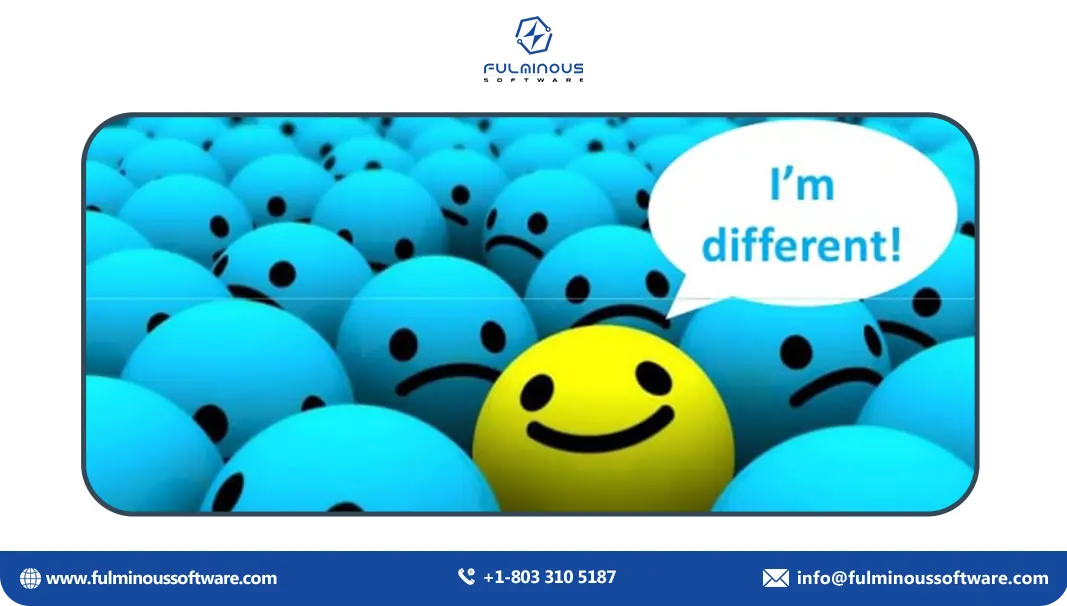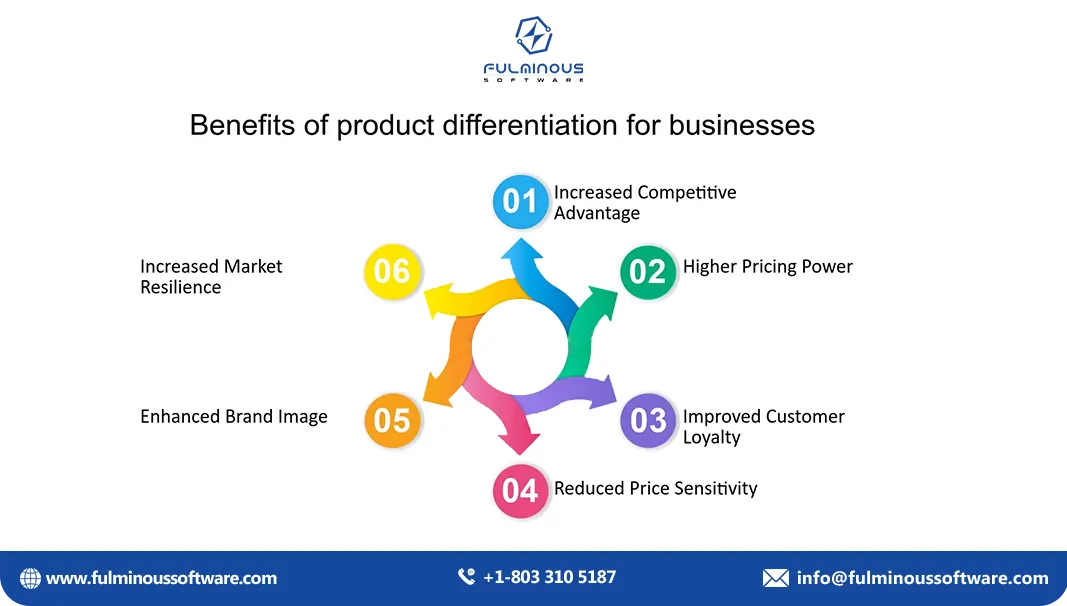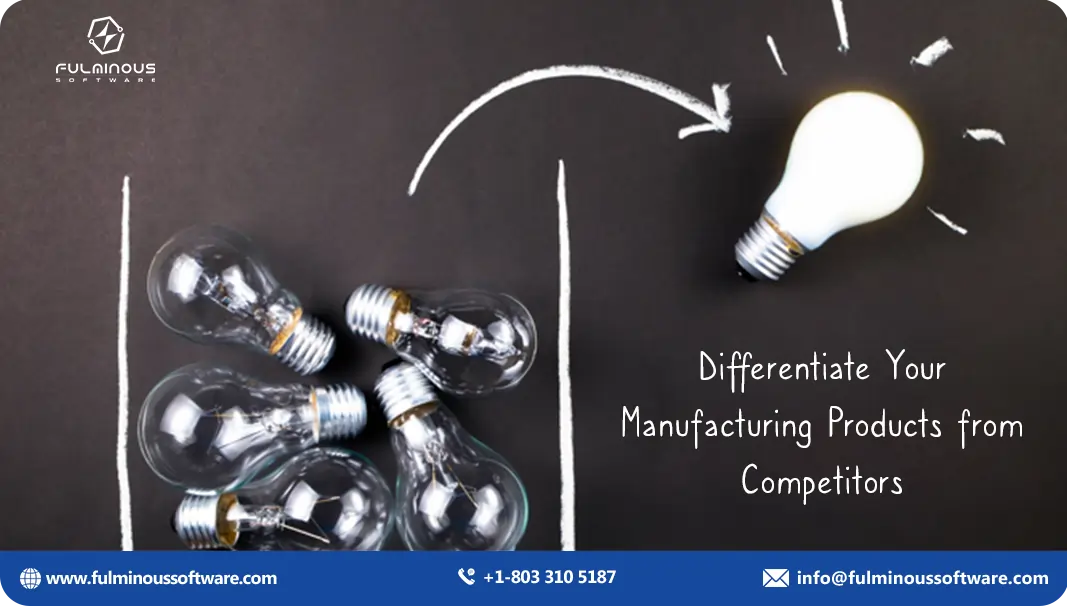How to Differentiate Your Manufacturing Products from Competitors
Manish Kumawat
Last Updated on: 07 October 2025
Let’s begin with reminding the truth! It's like an endless ocean, no matter which industry you are in. There are plenty of similar products that you manufacture, just like a crowd of fish looks similar. Ever felt like your manufacturing products are just another fish in an ocean of competitors? It's a frustrating reality! That’s why manufacturing business owners are always in search of the ideal ways to differentiate their manufacturing products.
For example:
When a person is shopping for a new phone, what makes them choose one over another? Is it just the specs? Or is it something more? Maybe it's the design, the innovative features, or even the brand's reputation for excellent customer service.
Then If you are a mobile manufacturing company, what will you do to attract that customer and make them choose your product over others?
That's exactly what we're talking about here. Differentiation isn't just about having a better product; it's about making your product feel better. It's about making your products more than just things and conquering a place in the hearts of customers. Therefore, if you don't have this, it's time to stand back and rethink your approach.

We'll go over some useful advice and techniques in this blog to assist you set your manufacturing items apart and be noticed by competitors. Get ready to produce items that people will cherish!
Remember! Customers Always Look for the Best and Unique Products

No manufacturing business wants its product to be just another option. If you have a unique product in whole manufacturing sector, customers will seek your product specifically. It's a reality, customers are picky. They want the best, the newest, the unique. Consider yourself as a customer. You will also choose the same. Is it?
The days of just getting by with a decent product are over. Customers are more selective than ever. They're reading reviews, comparing costs, and conducting research. If your product isn't offering something special, it will get lost in the shuffle.
So, what can you do to make your products shine? Think outside the box. Don't just follow the trends, set them. Be the innovator, not the imitator. Maybe it's a new feature, a better design, or even a unique story behind your product. Whatever it is, it needs to grab people's attention and make them think, "Wow, I didn't know I needed this."
Remember, it's not just about the product itself, but the experience it provides. Give your clients the impression that they are receiving something unique and unique.
Benefits of Product Differentiation

Think about your favorite brand. What makes it special? Is it the high quality, the attractive design, or maybe even the story behind it? Yes! it's a combination of all these elements. That's the power of differentiation.
When you differentiate your product, you're essentially making it stand out from the crowd. It's like being the only red flower in a field of yellow ones. People notice you, they remember you, and they're more likely to choose you.
You may increase sales of your product by making it stand out from the competition. You can so earn more money as a result. Customers who enjoy your product will keep purchasing it and recommending it to others. Their brand loyalty is a result of this.
It is more difficult for rival businesses in manufacturing industry to imitate your product if it is unique. This offers you an advantage over your manufacturing business rivals. Customers are pleased when you produce quality goods.
Remember, making your product different is a continuous process.
What If You Ignore Manufacturing Product Differentiation
If you ask successful manufacturing business owners, they will say spending millions of dollars in marketing is a waste if your manufacturing product is having no uniqueness. Ignoring product differentiation can have serious consequences for a manufacturing business. Here are some potential outcomes:
- Decreased Sales:If your product doesn't stand out from the competition, customers may choose alternatives. Drop in revenue and sales can be its result.
- Reduced Profit Margins:Without a unique selling point, you may have to compete on price alone. This can lower your profit margins and make it harder to sustain your business.
- Loss of Market Share:Competitors who differentiate their products effectively can gain market share at your expense.
- Weakened Brand Identity:A generic product can make it difficult to establish a strong brand identity.
- Increased Vulnerability to Competition:If your product is easily replicated, competitors can enter the market and undercut your prices.
In essence, ignoring product differentiation can make your business more vulnerable to market forces and less competitive. It's essential to find ways to make your products unique and valuable to customers in order to thrive in today's market.
Going Cheap Isn't the Only Way to Differentiate
When you hear "differentiate your products," you might think, "Oh, that means I need to offer the cheapest price on the market." But that's not always the case. In fact, going too cheap can actually hurt your brand's reputation and make it harder to compete long-term.
So, what does it really mean to differentiate your products? It's about finding a unique selling point that sets you apart from your competitors.
10 Tips to Differentiate Your Manufacturing Products from Competitors

Here are the 10 tips to Differentiate Your Manufacturing Products from Competitors. If you follow the tips, it is guaranteed, customers will buy your product even though there are thousands of products similar to yours.
1. Understand Your Target Market
Who are your clients? Determine which particular consumer or company segments are most likely to buy the things you manufacture. Take into account variables like age, gender, income, geography, industry, and size of the organization.
What is it they want and need? Examine the requirements, inclinations, and problems that your target market has with the particular product you offer. Recognize the issues or difficulties they are attempting to overcome.
What hurts them the most? Determine the particular annoyances, difficulties, or frustrations that your target market faces. You may better cater your products and marketing messages to their requirements and desires by being aware of their pain points.
2. Identify Your Unique Selling Proposition (USP):
What unique qualities do your items have?
Determine what sets your manufactured goods apart from those of your rivals. Excellent customer service, reasonable pricing, cutting-edge features, outstanding quality, and a distinctive brand narrative are a few examples.
In what way can you make your customers aware of this unique attribute?
Create a convincing value proposition that appeals to your target audience by highlighting the advantages and benefits of your USP. Communicate the distinctive value your items give succinctly and with eye-catching imagery.
3. Leverage Innovation and Technology:
When manufacturing, make use of the newest technologies.
To simplify production procedures, increase productivity, and cut expenses, invest in cutting-edge manufacturing hardware and software.
Your customers will adore the innovative and captivating features you create.
Make creative use of technology to increase functionality, create new product features, and elevate the user experience overall.
Continue to study and develop.
To investigate novel materials, technologies, and design ideas, spend money on research and development. To preserve a competitive edge, be abreast of developments and trends in your business.
4. Focus on Quality and Reliability:
Ensure that your items are at the top of their game.
Incorporate strict quality control procedures into all aspects of your production processes to guarantee that your products fulfill or surpass industry norms and client demands.
Make sure they are flawless by giving them a close inspection.
Before your products leave the plant, make sure you test and inspect them thoroughly to find and fix any flaws.
Establish a reputation for producing long-lasting goods.
Invest in strong designs, long-lasting materials, and dependable production processes to make sure your products last a long time and work consistently.
After the sale, provide excellent customer service.
Offer thorough warranties, repair services, and technical support to customers who might need help with their products or run into problems. This will bolster the credibility of your business and show how dedicated you are to ensuring consumer happiness.
5. Build Strong Customer Relationships
Give your clients the best treatment possible.
Make ensuring that customers are happy your top priority by offering outstanding support at every stage of the customer experience, from the first question to the post-purchase assistance.
To delight them, go above and above.
Provide individualized solutions, surpass client expectations, and professionally and quickly handle any issues or complaints.
Make each client feel unique.
Acknowledge and value the business your clients bring to you, and let them know how much you value their dedication. Make your interactions unique to them and customize your services to meet their demands.
Maintain contact with your clients.
Keep in constant contact with your consumers and notify them about new items, specials, and changes by using a variety of communication channels, including email, social media, and customized newsletters.
6. Consider Niche Markets:
Locate a particular clientele.
Determine the underserved market segments or niche groups with particular wants or preferences that the current product line does not sufficiently address.
Create goods exclusively for them.
Create goods that are specifically suited to the demands of the particular niche market you have selected. This could entail altering designs, specifications, or features.
Be the authority in that field.
Establish yourself as a source of inspiration and authority in the niche market of your choice. Speaking engagements, industry publications, and active participation in pertinent online groups can all help achieve this.
You can get a competitive edge, strengthen your client relationships, and differentiate your manufactured items by concentrating on specialized markets.
7. Pricing Strategy:
See how much your competitors are charging.
Find out how much your rivals in the market are charging for comparable products. You will then have a standard by which to measure your pricing.
In comparison, what are your prices?
Examine the elements—manufacturing costs, target market, and value proposition—that affect the pricing of your competitors.
Your target market and USP will help you determine how much to charge.
Take into account both the perceived worth your target market places on your manufactured product and its distinct value. A higher price could be acceptable if your product offers unique features, excellent quality, or a solid reputation as a brand.
If your product delivers a special value, think about charging more.
You might be able to charge more for your manufactured goods if they have unique features that set them apart from the competition, such as high-quality materials, cutting-edge technology, or limited-edition production.
8. Effective Marketing and Branding:
Make your brand appear powerful.
Create a distinctive brand identity that captures the essence of your manufacturing products and your company's goals and values.
Construct engaging and successful marketing initiatives.
To showcase the qualities and advantages of your items, use eye-catching marketing materials like brochures, ads, and social media posts.
Reach out to your customers in a variety of ways.
Target your audience more successfully by using a range of marketing channels, such as public relations, digital marketing, traditional advertising, and event marketing.
9. Sustainability and Corporate Social Responsibility:
Treat the environment with kindness.
Reduce the carbon footprint of your manufacturing facility by cutting waste, using energy-efficient procedures, and limiting pollution.
Encourage worthy causes.
To give back to society, make donations to nonprofits, engage in community service, or support regional events.
Communicate your concerns to others.
Use your website, social media accounts, and marketing materials to spread the word about your business's environmental and social responsibility programs.
10. Continuous Improvement:
Continue to learn.
Stay up to date with the latest advancements in manufacturing technologies and trends. Engage in industry events, peruse trade journals, and establish professional connections.
Observe market trends and pay attention to what your clients have to say.
Observe the offerings and costs of your rivals. Get input from your clients to learn about their preferences and needs.
Look for places where you can get better.
To find any possible flaws or inefficiencies, conduct routine audits of your production procedures and finished goods.
Seek methods for improving your products.
Look for ways to improve the look, feel, or quality of the product. Think about adding fresh elements, components, or styles.
To stay ahead, adapt.
Be prompt in putting changes into place and adjusting to the shifting market.
Important Tip: Set Your Products Apart with AI, IIoT, and ML

The most important tip is to use the best technologies available for the manufacturing process.
AI (Artificial Intelligence) can be a game-changer. It can help you automate tasks, improve efficiency, and even create new products. For example, AI-powered chatbots can provide 24/7 customer support, while AI-driven algorithms can optimize your production processes.
IIoT (Industrial Internet of Things) connects your machines and equipment to the Internet, allowing you to collect and analyze data in real time. This can help you identify bottlenecks, improve quality control, and reduce downtime. For instance, IIoT sensors can monitor the performance of your machines and predict when they need maintenance.
ML (Machine Learning) is a subset of AI that allows machines to learn from data and improve over time. It can be used to analyze customer behavior, predict demand, and even develop new product designs. For example, ML algorithms can analyze customer feedback to identify trends and improve your products.
How does this technology help to manufacture unique products?
These technologies can significantly enhance your ability to create unique products by:
1. Personalized Product Customization:
- AI-Powered Recommendations: AI can analyze customer data to suggest personalized product options, tailoring products to individual preferences and needs.
- Dynamic Product Configurations: IIoT-enabled platforms can allow customers to customize products in real-time, based on their specific requirements.
2. Optimized Product Design:
- Generative Design: AI algorithms can generate innovative product designs based on predefined constraints, such as material, cost, and functionality.
- Predictive Analytics: ML models can analyze historical data to predict product performance and identify potential design flaws.
3. Enhanced Quality Control:
- Real-time Monitoring: IIoT sensors can monitor production processes in real-time, detecting anomalies and preventing defects.
- Predictive Maintenance: AI-powered predictive maintenance can identify potential equipment failures before they occur, reducing downtime and ensuring product quality.
4. Innovative Materials and Processes:
- Material Discovery: AI can accelerate the discovery of new materials with desired properties, such as strength, durability, or sustainability.
- Process Optimization: ML algorithms can optimize manufacturing processes, identifying the most efficient and cost-effective methods.
5. Data-Driven Decision Making:
- Customer Insights: AI can analyze customer feedback and behavior data to identify trends and preferences, informing product development decisions.
- Market Analysis: ML models can predict market demand and identify emerging trends, helping you stay ahead of the competition.
By combining these technologies, you can create truly innovative and competitive products. For instance, you could use AI to develop a smart manufacturing system that uses IIoT sensors to optimize production and ML algorithms to predict demand. This would give you a significant advantage over competitors who are still relying on outdated methods.
Conclusion
In today's crowded market, making a good product isn't enough. You need to make it special and different. By adding unique features, focusing on quality, using new technology, and building strong relationships with customers, you can make your product stand out.
Understanding your customers is key. Then, make your product exactly what they want. You need to tell people what makes your product special and why they should choose it over others. Use new technology and always make sure your product is high quality. Pricing your product right is important. Think about what your competitors charge and how much your product is worth.
Marketing and branding are also important. Make sure people know about your product and why it's different. Being environmentally friendly and socially responsible can also help your brand. Pay attention to what's happening in your industry, listen to your customers, and always be looking for ways to make your product better.
To succeed in today's market, you need to be different. Start doing these things now and watch your products become more popular. Focus on innovation, quality, and customer relationships. You'll be successful if you do these things.
If you want to know more: Chat with us
FAQs
- 1. What is product differentiation in manufacturing?
- Product differentiation involves creating unique features or qualities that make your products stand out from the competition. It enhances design, functionality, and establishes a strong brand identity.
- 2. How can I identify my product’s unique selling proposition (USP)?
- To identify your USP, analyze your competitors’ strengths and weaknesses, highlight the exclusive features or benefits of your product, and understand your customers’ needs and pain points.
- 3. What role does innovation play in differentiation?
- Innovation introduces new features or improvements, enhances production efficiency, and keeps products relevant and appealing.
- 4. Why is focusing on quality important for differentiation?
- Focusing on quality builds a strong reputation for reliability, reduces customer complaints and returns, and encourages repeat purchases and referrals from satisfied customers.
- 5. How can I leverage technology to stand out?
- You can leverage technology by investing in advanced manufacturing equipment, implementing automation to increase precision and efficiency, and using technology to create innovative product features.
- 6. What are some ways to build strong customer relationships?
- Provide exceptional customer support, personalize interactions and services, and keep customers informed with updates and promotions.
- 7. How do niche markets help in product differentiation?
- Niche markets help by targeting specific, underserved customer segments, tailoring products to meet unique needs, and establishing your expertise in a specialized area.
- 8. What should I consider when setting product prices?
- When setting product prices, consider your competitors’ pricing and positioning, the perceived value of your product, and the costs of production along with your desired profit margins.
- 9. How can effective branding impact product differentiation?
- Effective branding creates a memorable and recognizable image, communicates product values and benefits clearly, and differentiates your brand from competitors.
- 10. Why is continuous improvement crucial for differentiation?
- Continuous improvement is crucial because it keeps your products updated with market trends, addresses customer feedback and evolving needs, and enhances product quality and functionality over time.
HIRE A TOP SOFTWARE DEVELOPMENT COMPANY

 Verified
Expert in Software & Web App Engineering
Verified
Expert in Software & Web App Engineering
I am Manish Kumawat, co-founder of Fulminous Software, a top leading customized software design and development company with a global presence in the USA, Australia, UK, and Europe. Over the last 10+ years, I am designing and developing web applications, e-commerce online stores, and software solutions custom tailored according to business industries needs. Being an experienced entrepreneur and research professional my main vision is to enlighten business owners, and worldwide audiences to provide in-depth IT sector knowledge with latest IT trends to grow businesses online
Partner with Top-Notch Web Application Development Company!
Discuss your Custom Application Requirements on info@fulminoussoftware.com or call us on +1-903 488 7170.
15 Days Risk-Free Trial

